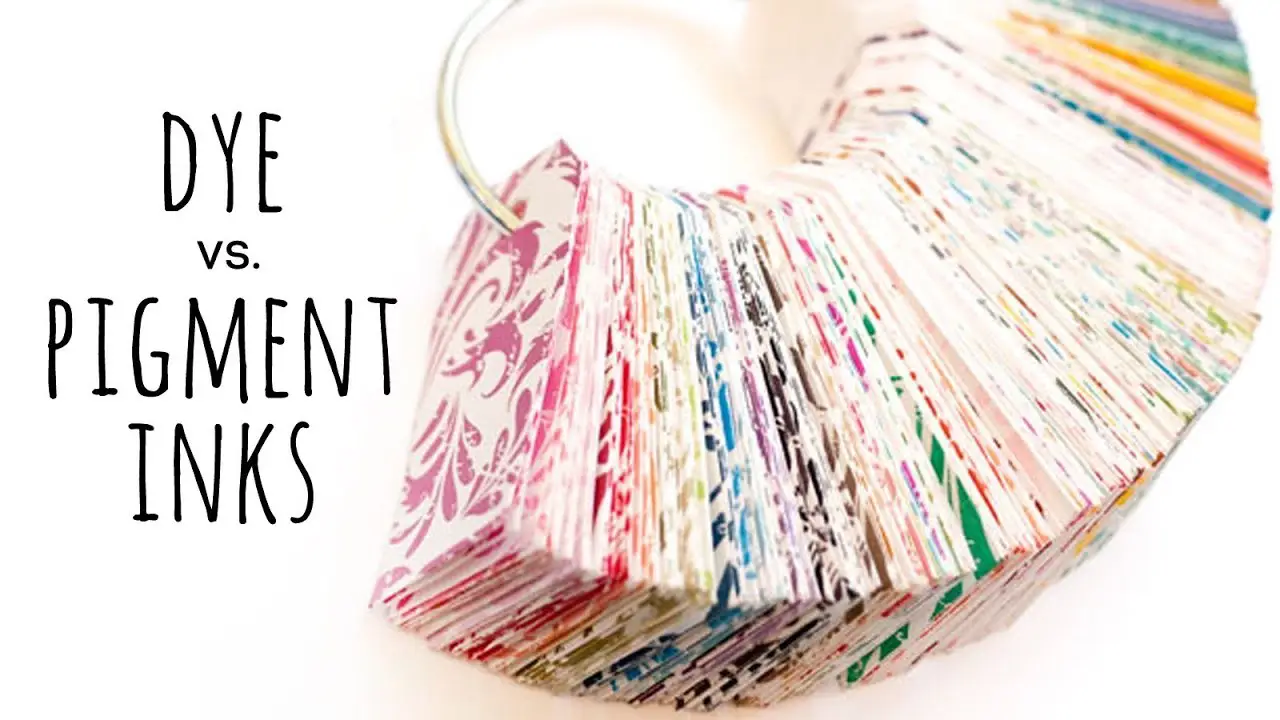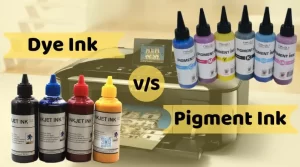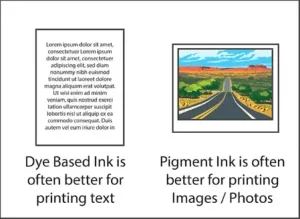Pigment Ink vs Dye Ink I Pick The Correct Ink

Are you an artist or hobbyist looking to step up your printing game? Picking the correct ink for your projects can sometimes be a daunting choice since such a wide variety is available. Pigment and dye inks are popular options, but what’s the difference? In this article, we’ll explore their properties and applications so that you can decide which type of ink to use for your next project. Read on to learn more about pigment ink vs dye ink!
Pigment ink vs Dye ink Table:
| Particular | Features | Pros | Cons |
| Pigment inks | Rich, Thick, Opaque, vibrant. It is frothy and sponge-like, has a glycerin base, is archival, long-lasting, and acid-free, and lies on top of the paper. | • It is water-resistant; • It doesn’t dry out quickly, making it perfect for heat embossing techniques. • It can be applied to a variety of wet media, including water coloring. • Lighter inks can be stamped onto dark cardstock. • The effect is fantastic and clear right immediately. | .The drying process is too slow. • It is easily smudged or smeared. • A heated tool is required for setting it. • More frequent reinking is required. |
| Dye Inks | It dyes the paper and is transparent, vibrant, absorbs into the felt pad, water-based, acid-free, and ideal for porous surfaces. | • It dries quite fast. The majority of businesses offer re-inkers for this kind of ink, and it doesn’t spread or smudge. • Rubber and transparent stamps can be used with ease. • It works well with a variety of card-making techniques, including stamping, stacked stamping, and mixed media. • It resists fading. • When compared to pigment ink pads, bleeding is minimized. | • It dries too rapidly, or it can take too long to spread out and dry into the paper. • It is not waterproof. • At first glance, it may appear blotchy. • Your finger is stained. • Watercolors and other water-based mediums cannot be used with it. |
What Is Pigment Ink?
Pigment-based ink is the type of ink used specifically for archival and professional printing. Unlike other inks, pigmented inks use tiny particles of solid colorant particles suspended in liquid instead of using the soluble dyes found in conventional inks.
As a result, these tiny pigment particles settle into the paper substrate better than traditional ink forms, leading to more excellent stability and longer-lasting prints. Pigment inks also tend to be more water-resistant when compared to standard dye-based print inks, which is why they’re an essential tool for any serious photographer or artist looking for custom fine art prints that won’t fade over time.
What Is Pigment Ink Made Of?
Pigment ink is water-resistant ink typically found in expensive printers, such as those used by professional photographers and graphic designers. It is composed of tiny particles of pigment suspended within a liquid, forming an ink that can sit on top of the paper rather than being absorbed into it like traditional dye-based inks.
This provides greater image longevity because pigment ink is far less susceptible to smudging, fading, and discoloration. Pigment ink is typically more expensive than other types of printer inks due to its higher quality materials and longer lifespan; however, it may be advantageous for long-term printing projects since it can save money and hassle in the long run.
Can you use Pigment ink in any Printer?
Pigment inks shouldn’t be used in printers designed for dye inks. Dye-based printer ink will soon become clogged with the substance used to make pigment inks. The colour substrates are dissolved in a liquid to create dye ink. However, solid, undissolved particles are present in pigment ink. These particles are what cause the dye-based printers to become clogged.
A few printers, such as inkjet printers, can use dye and pigment ink, although they are uncommon, frequently minor, and only print labels. Consider whether you require a pigment-based or dye-based ink printer before beginning your printer search.
What is Dye Ink?
Dye ink is a vivid and vibrant ink with a high intensity of colour produced by dissolving dyes into a liquid solution. Dye-based ink is commonly used in home printing, label coating, and commercial textiles.
This type of ink offers superior colour vibrancy compared to other types of pigment-based inks, as it can better achieve bright and bold hues that are reliably consistent over time. Further advantages include the fact that dye inks dry more quickly than pigments, do not require heated pressure to hold the colour on the substrate, and are resistant to fading from light exposure.
Despite its popularity and many features, dye inks have drawbacks too; for instance, the dyes tend to smudge if care isn’t taken when handling or using prints or when exposed to moisture.
Difference Between Pigment and Dye inks

It isn’t easy to distinguish between Dye or pigment-based inks, and neither can be compared. Even with technological advances, the human eye can no longer detect problems with printing ink, and they are still present.
Interaction with Water
The pigmented pigment has a better reaction with water. The Dye flows when touched by water. Pigments are less susceptible, though. Colour in a printed image produced from ink will disappear without using patterned labels or a special coating. It’s water-resistant as long as the label isn’t touched.
Composition
Printed cartridges using Dye are incredibly common today. Pigmented inking, however, is a new invention. Dye is a liquid substance, whereas pigment isn’t. Pigmentation forms in powder. Dye-based printing ink uses colour substances and colorants wholly dissolved in water. A pigment-based ink printer is a thin powder with solid colours in a liquid carrier that contains pigment.
Colour Stability
Well, they absorb Dye through fibres. The pigment particles are also attached to the surfaces of the paper. Put, pigments create a more significant layer of material than dyes. This makes printing in pigmented ink resistant to UV radiation and other external rays. Prints using pigment ink sets have fading resistance; the prints usually have longer lifespans.
Price
You’ll observe that the overall expenses for each are very different. For instance, dye inks are very affordable. Buying the entire palette might not even warrant second thoughts. Because most commercial dye inks are water-based, they are generally affordable.
Whilst pigment inks tend to be more expensive then dye based inks and the pigment requires more expensive materials and is more challenging to make. For instance, pigments require specific preparation techniques and are expensive to purchase.
Quality
Pigment-based inks are of higher quality compared to dye-based inks. Pigments are more saturated and vibrant and offer better reproduction of colours. Pigment-based inks are also resistant to fading and smudging, making them more durable than dye-based inks.
Pigment-based inks are especially advantageous for long-term printing projects since they can save money and hassle in the long run. Furthermore, pigment-based inks are more compatible with various substrates, making them ideal for any printing situation.
On the other hand, dye-based inks are highly affordable and widely available. They offer bright colours and quick drying times, making them ideal for small home projects or quick print jobs. Dye-based inks are less resistant to fading and smudging, making them less suitable for long-term projects. Furthermore, dye-based inks are less compatible with specific substrates and can cause troubles when printing on certain materials.
Which is Better: Dye vs Pigment ink?
The difference between dye and pigment inks is hugely significant in selecting the best option for your particular printing or art project. Both have unique benefits, but some projects may require one over the other.
Dye-based ink uses a liquid solvent, most commonly water, to suspend small solid particles of colourant. It allows for a more excellent range of colours and a greater detail than pigment inks making it the usual choice for fine art reproduction or photos with vibrant colours that need to be accurately rendered.
Pigment inks are formulated using finely ground pigment particles suspended in a bonding solution. These are much more resilient against fading and things like water and sunlight exposure, so they make a better choice for archival quality documents which need to last an extended period – such as maps and photographs that you’d like to keep preserved as priceless memories.
Both types of ink offer great results, however, so depending on what you’re hoping to achieve out of your project, Dye based or pigment-based inks could give you the perfect finished result.

Conclusion
In conclusion, dye-based inks are the go-to choice for those on a budget and wanting immediate results. Pigment-based inks are the better choice for long-term projects, as they are more durable and of higher quality. However, they can be more expensive and less compatible with specific substrates. It’s essential to consider your needs and budget before deciding which type of ink to use.
FAQs
Q: Can I use dye ink instead of pigment?
A: Yes, you can use dye ink instead of pigment. Dye inks are cheaper and offer quick drying times and bright colors. However, they are less resistant to fading and smudging and may not be suitable for long-term projects.
Q: Is pigment ink waterproof?
A: Yes, pigment ink is waterproof, as long as the label it’s printed on isn’t touched. The pigment particles are attached to the surfaces of the paper and create a more significant layer of material than dyes, making them more resistant to UV radiation and other external rays. This makes the prints more durable and longer lasting than dye-based inks.
Q: What are the differences between pigment ink and dye-based ink?
A: The main difference between pigment and dye ink is how the color is applied. Dye-based inks absorb Dye through fibers, while pigments create a more significant layer of material than dyes. This makes pigment-based inks more resistant to UV radiation and other external rays, resulting in prints that have longer lifespans and are more resistant to fading. Pigment-based inks are also more expensive than dye-based inks.
Q: How long do pigment inks last?
A: Pigment inks are more resistant to fading and smudging, resulting in prints that usually have longer lifespans than dye-based inks. Generally, prints made with pigment inks will last between 3 to 5 years before any fading or discoloration occurs. However, this may vary depending on the substrate it is printed on and other environmental factors.

I am Zamal Fatima, a skilled and experienced writer having a passion for technology, gadgets, printers, crafting, and DIY. As a technology expert, I have a deep understanding of the latest advancements in gadgets and devices and am able to produce insightful and informative articles that provide valuable insights into the world of technology. Always striving to improve my skills and knowledge.






